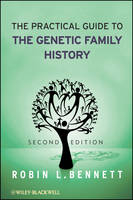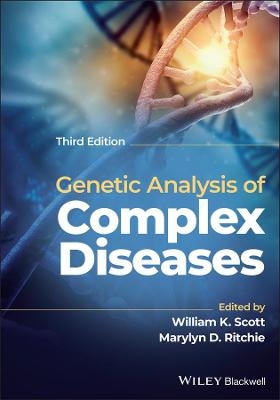
The Practical Guide to the Genetic Family History
Wiley-Blackwell (Verlag)
978-0-470-04072-0 (ISBN)
HELPS YOU DEVELOP AND ASSESS PEDIGREES TO MAKE DIAGNOSES, EVALUATE RISK, AND COUNSEL PATIENTS
The Second Edition of The Practical Guide to the Genetic Family History not only shows how to take a medical-family history and record a pedigree, but also explains why each bit of information gathered is important. It provides essential support in diagnosing conditions with a genetic component. Moreover, it aids in recommending genetic testing, referring patients for genetic counseling, determining patterns of inheritance, calculating risk of disease, making decisions for medical management and surveillance, and informing and educating patients. Based on the author's twenty-five years as a genetic counselor, the book also helps readers deal with the psychological, social, cultural, and ethical problems that arise in gathering a medical-family history and sharing findings with patients.
Featuring a new Foreword by Arno Motulsky, widely recognized as the founder of medical genetics, and completely updated to reflect the most recent findings in genetic medicine, this Second Edition presents the latest information and methods for preparing and assessing a pedigree, including:
Value and utility of a thorough medical-family history
Directed questions to ask when developing a medical-family history for specific disease conditions
Use of pedigrees to identify individuals with an increased susceptibility to cancer
Verification of family medical information
Special considerations when adoptions or gamete donors are involved
Ethical issues that may arise in recording a pedigree
Throughout the book, clinical examples based on hypothetical families illustrate key concepts, helping readers understand how real issues present themselves and how they can be resolved.
This book will enable all healthcare providers, including physicians, nurses, medical social workers, and physician assistants, as well as genetic counselors, to take full advantage of the pedigree as a primary tool for making a genetic risk assessment and providing counseling for patients and their families.
Robin L. Bennett has been a genetic counselor in the genetics clinic at the University of Washington Medical Center for over 20 years. She has proven and award-winning expertise in helping patients, families, and her colleagues at all levels deal with the multitude of practical, logistical, psychological, and diagnostic issues that are a day to day part of genetic counseling.
Illustrations and Tables xv
Foreword xxi
Preface xxiii
1. The Language of the Pedigree 1
1.1 Why Take Time to Record a Genetic Family History 1
1.2 What Do Cranes Have to Do with Anything? 2
1.3 The Pedigree is a Cost-Effective Tool for Genetic Diagnosis and Risk Assessment for Many Diseases 4
1.4 Just Do It© 5
1.5 The Pedigree as a Diagnostic Tool 5
1.6 Using the Pedigree to Decide on Testing Strategies and for Evaluating At-risk Relatives 6
1.7 Using the Pedigree to Establish the Pattern of Inheritance and Calculate Risks 6
1.8 A Pedigree Can Help Distinguish Genetic from Other Risk Factors 6
1.9 A Pedigree Can Document Shared Environment and Shared Genetic Risk Factors 8
1.10 A Pedigree Can Help Identify Medical Screening Needs for Healthy Individuals 8
1.11 Taking a Family History is aWay to Establish Client Rapport and Facilitate Patient Decision Making 8
1.12 A Pedigree Can Be Used for Patient Medical Education 9
1.13 Using a Pedigree to Explore a Patient’s Understanding and to Clarify Misconceptions 11
1.14 Other Family Diagrams: Genograms and Ecomaps 11
1.15 The Continuing Evolution of the Pedigree in the Age of Genomic Medicine 14
1.16 References 16
2. Practical Inheritance 18
2.1 A Tribute(ary) to Mendel 18
2.2 A Brief Genetics Primer 19
2.3 Types of Mutations 22
2.4 Single-Gene Disorders 23
2.5 Multi-Allelic Inheritance 23
2.6 Confounding Factors in Recognizing Patterns of Inheritance 23
2.7 Recognizing Patterns of Inheritance 25
2.8 Nontraditional Inheritance Patterns 36
2.9 Other Factors to Consider 43
2.10 Environmental Factors 44
2.11 Summary 44
2.12 References 45
3. Getting to the Roots: Recording the Family Tree 48
3.1 Creating a Medical Pedigree: Getting Started 48
3.2 Laying the Foundation—Pedigree Line Definitions 51
3.3 Keeping Track of Who is Who on the Pedigree 52
3.4 How Many Generations Are Included in a Pedigree? 53
3.5 The Basic Pedigree Symbols 55
3.6 Yours, Mine, and Ours—The Blended Family 55
3.7 Pedigree Symbols Related to Pregnancy and Reproduction 59
3.8 Assisted Reproductive Technologies (ART) and Use of Donor Gametes 59
3.9 Adoption 59
3.10 Infertility and No Children by Choice 60
3.11 Affected Status: Shading the Pedigree Symbols 60
3.12 A & W 61
3.13 “He Died of a Broken Heart”—Family Hearsay 61
3.14 Family History Unknown 61
3.15 Documenting Medical Examinations and Evaluations 61
3.16 A Note on Genetic Testing 64
3.17 The Healthy Person with an Abnormal Genetic Test Result: The Difference between a Presymptomatic or Asymptomatic Carrier and an Obligate Carrier 64
3.18 Pedigree Etiquette 65
3.19 Recording a Basic Pedigree: The Questions to Ask 68
3.20 The Closing Questions 77
3.21 The Family Photo Album 77
3.22 What’s Remarkable about an Unremarkable Family History? 79
3.23 Confidentiality and Family History 79
3.24 When is a Genetic Family History Significant? 80
3.25 The Ultimate Pedigree Challenge 80
3.26 Summary 81
3.27 References 81
4. Directed Medical-Genetics Family History Questions: Separating the Trees from the Forest 83
4.1 The Approach: Look for the Rare but Remember the Ordinary 83
4.2 Physical Birth Anomalies and Variants 87
4.3 Deafness/Hearing Loss 99
4.4 Vision Impairment 107
4.5 Intellectual Disability 113
4.6 Pervasive Developmental Disorders (PDD)/Autism Spectrum Disorder (Autism) 120
4.7 Cerebral Palsy 122
4.8 Neurological and Neuromuscular Disorders 125
4.9 Seizures 127
4.10 Stroke 131
4.11 Dementia 134
4.12 Mental Illness 138
4.13 Disorders Involving the Cardiac System 143
4.14 Chronic Respiratory Disease 146
4.15 Renal Disease 149
4.16 Skeletal Anomalies and Disorders of Short Stature 152
4.17 Diabetes 154
4.18 Multiple Miscarriages, and Male and Female Infertility 158
4.19 Sudden Infant Death Syndrome (SIDS) 168
4.20 Summary 169
4.21 References 169
5. Using a Pedigree to Recognize Individuals with an Increased Susceptibility to Cancer 177
5.1 Using Medical Family History to Identify Persons At Risk for an Inherited Cancer Syndrome 177
5.2 Information to Record in a Cancer Family History 193
5.3 Cancer Risk Assessment Requires Accurate Information on Cancer Diagnoses 193
5.4 Young Age of Onset is Typical of Inherited Cancer Syndromes 196
5.5 Rare Cancers Can Be a Clue to an Inherited Cancer Syndrome 197
5.6 Sex-limited, Sex-influenced, and Parent of Origin Effects (Parental Imprinting and Uniparental Disomy) 197
5.7 Environmental and Occupational Risk Factors for Cancer 198
5.8 Be Cautious in Assuming a Cancer is Sporadic or a New Mutation if the Cancer is Diagnosed at a Young Age or Is Uncommon 200
5.9 Family Ancestry is Important for Cancer Risk Assessment 206
5.10 Consanguinity and Cancer Risk Assessment 206
5.11 Cancer Worry: The Pedigree as a Psychosocial Tool 208
5.12 Models for Predicting the Risk of Developing Cancer or the Probability of Testing Mutation-Positive for an Inherited Cancer Syndrome 209
5.13 Summary 211
5.14 References 212
6. Medical Verification of Family History, and Resources for Patients to Record Their Genetic Family Histories 220
6.1 Validation of Family Medical Information is a Necessity 220
6.2 How to Approach Family Members 222
6.3 The Privacy of a Person’s Life 222
6.4 Requesting Medical Documentation 223
6.5 Shifts in Medical Terminology 225
6.6 Empowering Your Patients with Tools for Recording Their Own Medical-Family Histories 226
6.7 Software Programs for Recording Family Histories 227
6.8 Resources from the Genealogical Gurus 228
6.9 Summary 228
6.10 References 229
7. The Challenge of Family History and Adoption 230
7.1 The Problem Defined 230
7.2 Evolving Adoption Laws 231
7.3 Obtaining Medical Information from a Closed Adoption 234
7.4 Genetic Testing of Children Being Placed for Adoption 235
7.5 A Model Medical and Genetic Family History form for Adoptions 236
7.6 Summary 236
7.7 References 237
8. Family History and Assisted Reproductive Technologies 239
8.1 Gamete Donation Allows Couples at High Risk for Genetic Disorders to Have Healthy Offspring 239
8.2 Screening Gamete Donors for Inherited Disorders 241
8.3 Intractyoplasmic Sperm Injection and Genetic Disease 243
8.4 Representing Gamete Donation and Surrogacy on a Pedigree 243
8.5 The Forgotten Family History: The Offspring of Donor-Conceived Pregnancies 245
8.6 Summary 245
8.7 References 246
9. Genetic Counseling: Where to Turn, What to Expect, and the Pedigree as a Psychosocial Assessment and Counseling Tool 247
9.1 Genetic Conditions Have Distinguishing Aspects from Other Medical Conditions 247
9.2 The Pedigree as a Tool in Psychosocial Assessment and Counseling 251
9.3 The Process of Genetic Counseling 253
9.4 What to Expect from a Genetics Consultation 253
9.5 Genetic Counselors and Other Genetic Specialists 255
9.6 Locating a Genetics Professional 256
9.7 Summary 256
9.8 References 256
10. Pedigree Predicaments 259
10.1 The Truth 259
10.2 Lessons from History 261
10.3 The Researcher and Family Studies 263
10.4 Pedigrees and Publications 264
10.5 Pedigrees and the Electronic Medical Record 267
10.6 Summary 271
10.7 References 272
Glossary 274
A.1. Handy Reference Tables of Pedigree Nomenclature 287
A.2. Sample Clinical Pedigree Form 290
A.3. Sample Genetic Screening Form for Familial Cancer Risk Assessment 292
A.4. Sample Adoption Medical-Family History Form 295
A.5. The Genetics Library 308
A.6. Genetics in Practice: Five Case Studies 313
A.7. List of Genetic Disorders, Gene Symbols and Names, and Patterns of Inheritance 327
Index 340
| Zusatzinfo | Photos: 20 B&W, 0 Color; Drawings: 25 B&W, 0 Color |
|---|---|
| Verlagsort | Hoboken |
| Sprache | englisch |
| Maße | 152 x 231 mm |
| Gewicht | 544 g |
| Themenwelt | Studium ► 2. Studienabschnitt (Klinik) ► Humangenetik |
| ISBN-10 | 0-470-04072-6 / 0470040726 |
| ISBN-13 | 978-0-470-04072-0 / 9780470040720 |
| Zustand | Neuware |
| Informationen gemäß Produktsicherheitsverordnung (GPSR) | |
| Haben Sie eine Frage zum Produkt? |
aus dem Bereich


